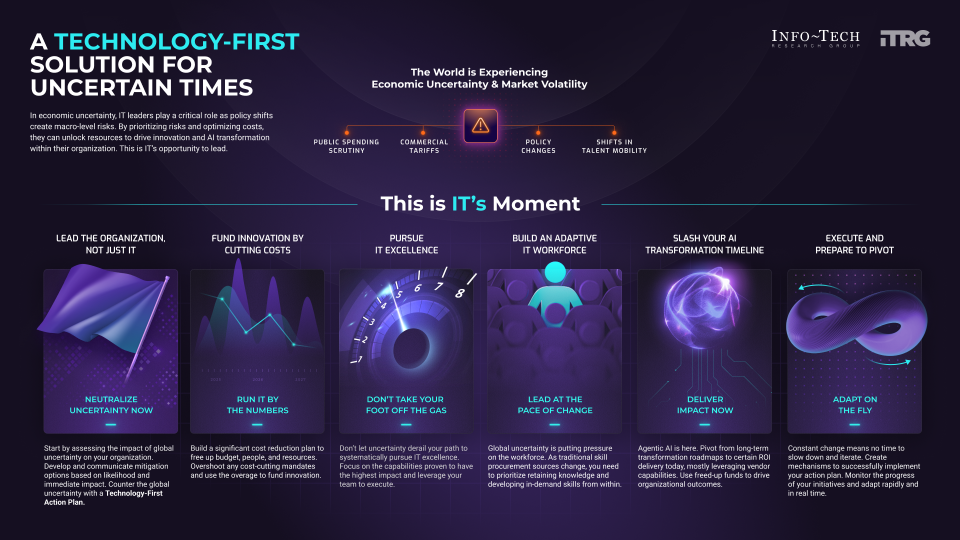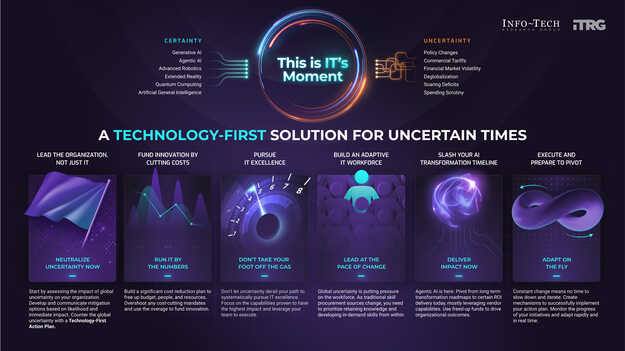Economic volatility, policy upheaval, and escalating digital threats are fundamentally reshaping how nonprofits secure funding, maintain donor trust, and deliver on their missions – just as budgets shrink and the need for the services nonprofits provide continues to rise. These are no longer temporary shocks, but long-term structural challenges requiring deep organizational adaptation. Our step-by-step blueprint empowers nonprofit technology leaders to build a mission-driven Technology-First Action Plan that transforms today’s challenges into tomorrow's capacity.
In the face of these headwinds, technology should be regarded not as a back-office function or line item, but a stabilizing force. By streamlining operations, safeguarding stakeholder data, modernizing service delivery, and enabling transparency, IT can anchor organizational resilience. Nonprofit leaders and decision-makers must reframe technology as a core strategic asset essential to weathering today’s crises while delivering long-term impact.
1. Cut costs to free up resources for innovation.
Though innovation plays a key role in helping nonprofits extract maximum value from limited funding, it is often the first to see its budget slashed amid budget shocks. Nonprofit leaders must cut unnecessary costs and redirect that spending to the people, resources, and budgetary capacity their innovation efforts will need to overcome today’s turmoil.
2. Meet the moment. Take the lead.
As much as today’s uncertainty is a strain on IT resources, it can also be an opportunity. By demonstrating that technology can be used not only to solve problems but also to enable better decision-making, nonprofit technology decision-makers can get the most out of limited resources, as well as showcase their ability to lead.
3. Build an adaptive IT team.
With technology advancing at an exponential rate, you will never permanently close the skills gap. Focus instead on building sustainable learning and development practices to enable your staff to retain knowledge and develop in-demand skills as they are needed.
Use this step-by-step blueprint to realign nonprofit sector IT into a posture of resilience
Our research offers guidance and templates to make a clear assessment of IT’s strengths and vulnerabilities, and where they can be leveraged. Use our Technology-First Action Plan framework to empower IT to lead their organization through the challenges facing the nonprofit sector.
- Assess uncertainties and opportunities by leveraging this moment to explore where the organization is most vulnerable and where it is most poised to further lean into technology risks.
- Review IT Spend & Staffing tools and services to find costs that can be either cut or channelled toward innovation opportunities.
- Build your Technology-First Action Plan by identifying and prioritizing initiatives that will drive the organization forward and consolidate those initiatives into a 12-month plan.
- Prepare to execute by defining the organizational value of your plan and building an adjustable communications strategy to bring stakeholders on board.
Adapt to Uncertainty With a Technology-First Action Plan for Nonprofits
Cost cutting in times of crisis works; doubling down on innovation works even better.
Analyst perspective
In times of disruption, mission resilience depends on innovation and strategic use of technology.
The nonprofit sector stands at a pivotal moment. Economic strain, geopolitical instability, shifting regulations, and rising digital threats are converging to test organizational resilience. These macro-level disruptions are no longer temporary shocks. They are structural forces reshaping how nonprofits secure funding, earn trust, and deliver on their missions.
Amid this volatility, technology is emerging as a critical enabler of stability and progress. It allows nonprofits to streamline operations, protect stakeholder data, adapt service models, and demonstrate accountability to funders. Those who treat technology as a core strategic asset, rather than an overhead line item, will be best positioned to navigate uncertainty and scale their impact.
Build a mission-driven technology action plan that transforms today's challenges into tomorrow's capacity.

Vidhi Trivedi
Research Analyst
Info-Tech Research Group
Please note: This research was developed with the assistance of generative AI. For information about how, please see in the Appendix.
Executive summary
Your challenge
In 2025, nonprofit organizations face an increasingly volatile operating environment shaped by global disruptions, rising compliance burdens, and digital threats. These macro-vulnerabilities are testing their ability to fulfill their missions, retain donor trust, and deliver impact, all while budgets shrink and needs grow.
Policy Shifts & Compliance Overload
Policy volatility is creating serious friction. In January 2025, the White House froze new foreign aid for 90 days pending multi-agency reviews (White House, 2025). Canada's Official Development Assistance (ODA) stood at $10.2B in 2023-2024, with advocates urging a $10.6B baseline for 2025-2026 to match inflation, yet 30% was spent domestically, nearly a quarter more than to Sub-Saharan Africa (Cooperation Canada, 2025).
Nonprofits face rising compliance and financial strain. 55% of leaders cite financial health as their top concern, and 67% rely on government grants that account for 25% of average revenue. With two-thirds of grantees unable to cover expenses if those funds disappeared, shifting policies and compliance mandates carry heightened risk (Urban Institute, 2025).
Funding Instability & Inflation Pressure
Global aid cuts are deepening instability. Germany's draft 2025 budget reduces humanitarian aid from €2.23B in 2024 to €1.04B — a 53% cut (Devex, 2025). In the UK, international aid is forecast to fall to just 0.36% of national income in 2024, its lowest level since 2007, with a shelved £707M World Bank contribution signaling further retrenchment (Devex, 2025).
Nonprofit leaders echo this fragility. 55% cite financial health as their top concern, 81% focus on revenue uncertainty, and 75% expect demand for services to rise in 2025 (Urban Institute, 2025).
Inflation magnifies the strain. Rising costs push nonprofits to trim budgets, share services, and prioritize donor retention (BerryDunn, 2025). Many are already scaling back programs, freezing hiring, or dipping into reserves as funding becomes less reliable.
Rising Digital & Cybersecurity Risk
Nonprofits' digital reliance makes them prime targets. 27% have already suffered attacks, often due to outdated systems (CyberCommand, 2025). Ransomware causes an average 22 days of downtime, and Broward Health's breach of 1.35M records shows how quickly trust and operations can collapse (CyberCommand, 2025).
Threats are escalating. Nonprofits face phishing, vishing, deepfakes, and supply chain exploits, while unchecked AI adoption adds risks in privacy and accuracy. Weak vendor oversight magnifies exposure (Plante Moran, 2025).
Compliance pressure is rising. The OMB's revised Uniform Guidance (Oct. 1, 2024) requires reasonable data safeguards (2 CFR 200.303e) and directs agencies to assess cyber risk before awards (OMB, 2024). With NIST CSF, CIS Controls, and CISA CPGs as baselines, cybersecurity is now a funding requirement.
Executive summary
Common obstacles
For nonprofit leaders and technology decision-makers, these vulnerabilities create urgent operational and strategic barriers that limit mission delivery, innovation, and long-term sustainability.
Forced to Be in Reactive Mode
Nonprofits are often caught off guard by aid freezes, shifting compliance rules, or donor withdrawals. Without risk planning or IT-enabled agility, many remain stuck in a reactive cycle.
Urban Institute data shows the depth of this fragility: 67% of nonprofits reliant on government grants could not cover expenses if funding disappeared. Workforce strain compounds the issue — 72% cite salary competition and 66% cite budget constraints as major barriers to retention. At the same time, 75% expect demand for services to rise in 2025 (Urban Institute, 2025).
These pressures force organizations to pause initiatives, freeze hiring, or delay investments in scalable systems, leaving them vulnerable to the next disruption.
Underdeveloped Digital & Cyber Capabilities
Legacy systems, tight budgets, and limited IT staff leave nonprofits digitally exposed. GRF notes that smaller organizations without centralized IT governance are prime targets, especially as cybercriminals now use AI to launch harder-to-detect attacks (GRF, 2025). Many nonprofits also over-rely on SaaS vendors, assuming providers handle all protections, when critical gaps remain under the nonprofit's control (GRF, 2025).
These weaknesses carry compliance consequences. Recent updates to federal grant guidance extend required safeguards beyond PII to any sensitive organizational data, reinforcing that cybersecurity is not just an IT issue but a condition of funding (OMB, 2024).
Without stronger systems and dedicated security practices, technology risks becoming a liability rather than a driver of mission delivery.
Severe Resource Constraints
Nonprofits enter 2025 under mounting strain. BerryDunn notes that economic uncertainty is forcing organizations to retain donors, adapt to shifting grants, manage inflation, and meet tougher compliance standards (Bednarski, 2025). Workforce challenges further squeeze budgets as nonprofits struggle to compete for talent.
Technology shortfalls magnify the problem: 45% of nonprofits still depend on legacy applications, 72% take days to compile financial or operational data, and only 7% can access it in real time (Unit4/PAC, 2025). These delays mean 85% need up to two weeks to launch fundraising initiatives and 37% take as long to activate field programs (Unit4, 2025).
Together, rising costs, compliance demands, and outdated systems create a cycle of resource scarcity that slows modernization and increases risk.
Executive summary
Resolution
Explore the entire suite of research that supports these pillars by visiting our research center IT's Moment: A Technology-First Solution for Uncertain Times.
Lead the Organization, Not Just IT
Neutralize Uncertainty Now
Fund Innovation by Cutting Costs
Run IT by the Numbers
Pursue IT Excellence
Don't Take Your Foot off the Gas
Build an Adaptive IT Workforce
Lead at the Pace of Change
Slash Your AI Transformation Timeline
Deliver Impact Now
Execute and Prepare to Pivot
Adapt on the Fly
Info-Tech's Approach
Phase 1 – Assess Uncertainties & Opportunities
Phase 2 – Review Budget, Staffing & Contracts
Phase 3 – Build Your Technology-First Action Plan
Phase 4 – Get Ready to Execute!

1 Lead the Organization, Not Just IT
Neutralize Uncertainty Now
- Defuse Uncertainty Drivers: Understand organizational impact.
- Lean Into the Curve: Apply Exponential IT.
- Pick Your First Bets: Deliver use cases now.
- Claim Your New Mandate: Technology-first or go out of business.
- Get the Word Out: Tell the entire organization now.
Start by assessing the impact of global uncertainty on your organization. Develop and communicate mitigation options based on likelihood and immediate impact. Counter the global uncertainty with a technology-first action plan.
2 Fund Innovation by Cutting Costs
Run IT by the Numbers
- Don't Bet the Farm: Set the innovation budget.
- Find Real Dollars Quickly: Cut costs now.
- Demonstrate Technology Impact: Benchmark spend and shift.
- Shorten the Cycles: Build a flexible budget (finally).
- Sharpen the Pencil: Renegotiate vendor contracts.
Build a significant cost reduction plan to free up budget, people, and resources. Overshoot any cost-cutting mandates and use the overage to fund innovation.
Only 20% of CFOs are happy with the impact tech investments make on their business (Rimini Street, 2024).
3 Pursue IT Excellence
Don't Take Your Foot off the Gas
- Get the Baseline: Understand your maturity.
- Focus on What Really Matters: Improve your critical capabilities.
- You Can't Do IT Alone: Guide your team.
- Enable Everyone: Provide tools and training.
- Aim High Selectively: Leapfrog for impact.
Don't let uncertainty derail your path to systematically pursue IT excellence. Focus on the capabilities proven to have the highest impact and leverage your team to execute.
85% of core processes are ineffective on average across all IT organizations (Info-Tech IT Management & Governance Diagnostic, 2024).
4 Build an Adaptive IT Workforce
Lead at the Pace of Change
- Knowledge Is Power: Stop the drain.
- Drive Adaptability: Be it and teach it.
- Lead the Pack: Autonomize aggressively.
- Fill Your Gaps: Build critical skills.
- Win the Race for Talent: Money isn't everything.
Global uncertainty is putting pressure on the workforce. As traditional skill procurement sources change, you need to prioritize retaining knowledge and developing in-demand skills from within.
IT positions that are going unfilled are costing organizations in the United States an average of $187 billion in lost revenue each year (CompTIA, 2024).
5 Slash Your AI Transformation Timeline
Deliver Impact Now
- Just Do It: Deliver AI now.
- Stop Saying No: Democratize AI.
- Spend, Spend, Spend: Overfund innovation.
- Have ONE Strategy: AI Strategy = IT Strategy = Enterprise Strategy
- If in Doubt, Buy Over Build: Select the right vendors.
Agentic AI is here. Pivot from long-term transformation roadmaps to certain ROI delivery today, mostly leveraging vendor capabilities. Use freed-up funds to drive organizational outcomes.
CEOs believe that the researching and implementing AI is the top IT priority (Foundry, 2025).
6 Execute and Prepare to Pivot
Adapt on the Fly
- Aim for Impact: Say yes to promising pilots.
- Measure What's Real and Fund What Works: Fund based on outcomes.
- Let Things Go. Kill failing projects quickly.
- Shatter the Org Chart: Match talent to impact.
- It's Not Bragging If It's True: Share wins and failures.
Constant change means no time to slow down. Create mechanisms to successfully implement your action plan. Monitor the progress of your initiatives and adapt rapidly and in real time.
Nonprofits that prioritize technology now are positioned to lead the sector in resilience, efficiency, and impact
Operational Challenges & Technology Gaps
According to Sage's 2025 Nonprofit Technology Impact Report:
- Forty-one percent of respondents report lack of process automation and organizational inefficiency as their top internal challenge, and 35% cite time-consuming manual reporting. Real-time dashboards remain elusive for 34%.
Digital Maturity Drives Outcomes
According to Blackbaud's The Status of Fundraising in the AI Era:
- Organizations with higher levels of technology integration are significantly more likely to meet or exceed fundraising goals.
- Seventy-two percent of respondents met or surpassed their targets over the last 12 months.
- Yet only 14% have a formal AI policy, and most report inconsistent adoption across donor, program, and internal systems.
Cost & Demand Pressures Necessitate Tech Adoption
According to research by Pierre Audoin Consulting (Unit4, 2025):
- Seventy-nine percent of nonprofits expect rising demand for services while facing escalating costs.
- Nearly half identified legacy systems as the top barrier to digital transformation.
- The average nonprofit takes one to two weeks to launch fundraising campaigns or activate programs – due to siloed systems and poor data integration.
Cost cutting in times of crisis works.
Doubling down on innovation fuels long-term mission impact.
Innovation outpaces austerity
While other organizations may respond to budget cuts by scaling back operations, nonprofit leaders should show how digital innovation can drive more value through optimized resource efficiency. From digitized service delivery to AI-enhanced donor outreach, innovation helps amplify limited resources and accelerate impact.
Starve waste, feed a revolution
Cut inefficiencies now so you can preserve the budget for innovation when it matters most. Investing in tools that automate reporting, streamline program workflows, or improve donor tracking gives your team capacity to serve and not just survive.
Technology powers better impact decisions
This is the moment to show that technology is not overhead, but a strategic partner. Use IT to unlock insights into community needs, grant performance, and donor engagement. Demonstrate how digital tools inform smarter, faster decisions across the organization.
Always be learning
The exponential rate of technology development and adoption means nonprofit organizations will never close the skill gap again, especially for IT. Focus on establishing sustainable learning and development practices that allow staff to upskill and apply those skills quickly.
Change is constant; struggle is optional
Change is inevitable, but it doesn't have to be hard. Establish adaptive practices in your change plan to ensure that it remains on track and continuously moves in the right direction.
Info-Tech's methodology for building a Technology-First Action Plan
| 1. Assess Uncertainties & Opportunities | 2. Review Budget, Staffing & Contracts | 3. Build Your Technology-First Action Plan | 4. Get Ready to Execute | |
|---|---|---|---|---|
| Key Activities |
|
|
|
|
| Phase Outcomes | Understand the risks that vulnerabilities are creating for your organization and the technology-enabled opportunities that need to be seized. | Review your IT budget to determine where there are opportunities to cut costs relentlessly. Funnel these cost savings toward innovative opportunities. | Prioritize initiatives that will drive the organization forward in times of uncertainty. Establish a 12-month roadmap showing when each initiative can be achieved. | Succeed at the action plan with a clear change and communication approach to enable adaptability in the moment when new vulnerabilities inevitably emerge. |
Each phase of this blueprint is accompanied by phases of the supporting deliverable to help you accomplish your goals:
Uncertainties & Opportunities Assessment
Identify how macro-uncertainties are generating new risks for your organization and opportunities to leverage technology more effectively.
IT Spend & Staffing Benchmarking
Assess the current IT spend across systems, contracts, projects, and the workforce to identify cost optimization opportunities.
Technology-First Action Plan Roadmap
Identify key initiatives that IT will pursue and deliver against over the next 12 months to reduce the impacts of uncertainties.
Communication & Execution
Define and prepare to communicate how the Technology-First Action Plan will deliver organizational value.
Key deliverable:
Technology-First Action Plan
Build a Technology-First Action Plan that demonstrates how IT can lead the organization in responding to ongoing uncertainties.
Blueprint benefits
| IT Benefits | Organizational Benefits |
|---|---|
|
|
Measure the value of this blueprint
The objective of this blueprint is to improve not just IT's value, but the organization's value.
ORGANIZATIONAL VALUE
Mission Acceleration
- Year-over-year (YoY) constituent growth
- Expansion of digital or remote service offerings
- New programs launched or piloted faster
Cost Optimization
- Administrative cost ratio or overhead ratio
- Grant and fund utilization rate
- Procurement savings vs. baseline
- Program cost per beneficiary
Operational Efficiency
- Staff time saved through automation
- Downtime reduction for service-critical systems
- Ratio of administrative cost to direct program delivery
Constituent Satisfaction
- Service satisfaction scores
- Constituent or beneficiary/donor feedback ratings
- Net Promoter Score (NPS)
- Donor retention and growth
- Constituent engagement continuity
- Mission Acceleration: Expand the reach and pace of impact by using technology to launch new programs, scale services, and respond faster to community needs.
- Cost Optimization: Maximize the value of every dollar by improving how resources are allocated, minimizing inefficiencies, and strengthening funder confidence.
- Operational Efficiency: Improve internal capacity and agility by streamlining workflows, reducing manual effort, and ensuring critical systems support mission delivery.
- Constituent Satisfaction: Strengthen trust and engagement with beneficiaries, donors, and partners through responsive, transparent, and data-informed service experiences.
Research Note:
Beyond Automation, Beyond Borders: Cultivating Your Talent in a New Global Reality

Fred Chagnon
Principal Research Director
Info-Tech Research Group
While the discourse around artificial intelligence, particularly generative AI, often emphasizes workforce displacement, a strategy fixated on replacing human workers with AI is shortsighted. True value creation in the AI era demands a strategic investment in people – employees and partners – to augment, manage, and innovate with these technologies.
This imperative is critically amplified by emerging de-globalization trends that are reshaping global talent pipelines and increasing the need for organizational self-sufficiency. Sustainable success, innovation, and resilience will therefore hinge on an organization's commitment to cultivating in-house talent, focusing on skills for AI, cybersecurity, and adaptive leadership to effectively navigate a future defined by human–AI cocreation.
"The evidence suggests that, rather than seeking to replace people with AI, organizations that prioritize employee development alongside their AI investments will be better positioned to innovate, navigate ethical complexities, build customer trust, and ultimately unlock the full, transformative potential of AI and other exponential technologies.
In an era where both technological disruption and geopolitical fragmentation demand greater organizational resilience, focusing on developing our people internally becomes the linchpin of any successful AI strategy and, indeed, overall business strategy."
Info-Tech offers various levels of support to best suit your needs
| DIY Toolkit | Guided Implementation | Workshop | Executive & Technical Counseling | Consulting |
|---|---|---|---|---|
| "Our team has already made this critical project a priority, and we have the time and capability, but some guidance along the way would be helpful." | "Our team knows that we need to fix a process, but we need assistance to determine where to focus. Some check-ins along the way would help keep us on track." | "We need to hit the ground running and get this project kicked off immediately. Our team has the ability to take this over once we get a framework and strategy in place." | "Our team and processes are maturing; however, to expedite the journey we'll need a seasoned practitioner to coach and validate approaches, deliverables, and opportunities." | "Our team does not have the time or the knowledge to take this project on. We need assistance through the entirety of this project." |
Diagnostics and consistent frameworks are used throughout all five options.
